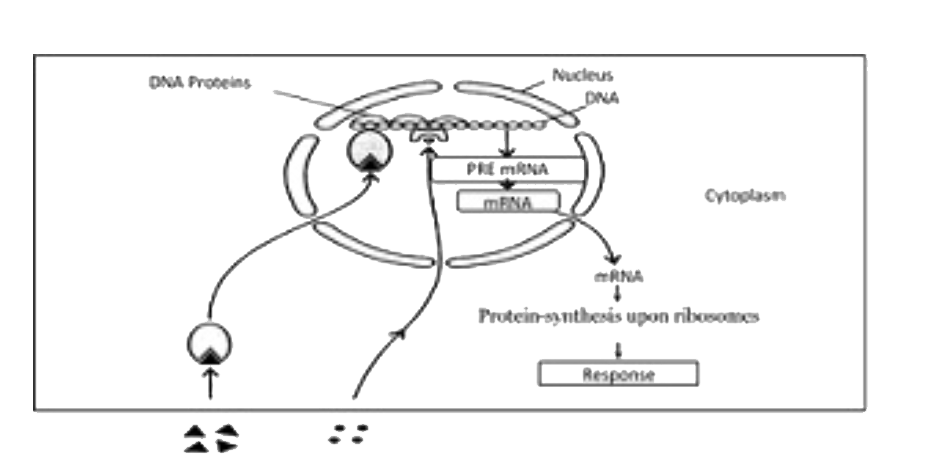Generation of second messengers is not possible in which of the given set of hormones ?
Epinephrine, insulin glucagon
Estrogen, cortisol, thyroxine
FSH, LH, oxytocin
Estradiol, oxytocin, FSH
The correct Answer is:B
To determine which set of hormones does not generate second messengers, we need to analyze the types of hormones listed and their mechanisms of action.
1. Identify the Types of Hormones:
- Hormones can be classified into three main categories based on their chemical nature:
- Peptide Hormones: These include insulin, glucagon, FSH, LH, and oxytocin. They typically bind to membrane-bound receptors and often generate second messengers.
- Steroid Hormones: These include cortisol, estrogen (estradiol), and testosterone. They usually bind to intracellular receptors and do not generate second messengers.
- Amino Acid Derivatives: Epinephrine is an example and can generate second messengers.
2. List the Given Hormones:
- The hormones mentioned in the question are:
1. Epinephrine
2. Insulin
3. Glucagon
4. Estrogen
5. Cortisol
6. Thyroxine
7. FSH
8. LH
9. Oxytocin
10. Estradiol
11. Oxytocin (repeated)
12. FSH (repeated)
3. Determine Which Hormones Generate Second Messengers:
- Peptide Hormones (generate second messengers):
- Insulin, Glucagon, FSH, LH, Oxytocin
- Steroid Hormones (do not generate second messengers):
- Cortisol, Estrogen (Estradiol)
- Thyroid Hormones (do not generate second messengers):
- Thyroxine (T4)
- Amino Acid Derivative (generates second messengers):
- Epinephrine
4. Conclusion:
- The hormones that do not generate second messengers are primarily the steroid hormones (Cortisol, Estrogen) and the thyroid hormones (Thyroxine). Therefore, the correct answer to the question is the set containing Cortisol, Estrogen, and Thyroxine.
Final Answer:
The generation of second messengers is not possible in the set of hormones that includes Cortisol, Estrogen, and Thyroxine.
- Hormones can be classified into three main categories based on their chemical nature:
- Peptide Hormones: These include insulin, glucagon, FSH, LH, and oxytocin. They typically bind to membrane-bound receptors and often generate second messengers.
- Steroid Hormones: These include cortisol, estrogen (estradiol), and testosterone. They usually bind to intracellular receptors and do not generate second messengers.
- Amino Acid Derivatives: Epinephrine is an example and can generate second messengers.
- The hormones mentioned in the question are:
1. Epinephrine
2. Insulin
3. Glucagon
4. Estrogen
5. Cortisol
6. Thyroxine
7. FSH
8. LH
9. Oxytocin
10. Estradiol
11. Oxytocin (repeated)
12. FSH (repeated)
- Peptide Hormones (generate second messengers):
- Insulin, Glucagon, FSH, LH, Oxytocin
- Steroid Hormones (do not generate second messengers):
- Cortisol, Estrogen (Estradiol)
- Thyroid Hormones (do not generate second messengers):
- Thyroxine (T4)
- Amino Acid Derivative (generates second messengers):
- Epinephrine
- The hormones that do not generate second messengers are primarily the steroid hormones (Cortisol, Estrogen) and the thyroid hormones (Thyroxine). Therefore, the correct answer to the question is the set containing Cortisol, Estrogen, and Thyroxine.
The generation of second messengers is not possible in the set of hormones that includes Cortisol, Estrogen, and Thyroxine.
Topper's Solved these Questions
Similar Questions
Knowledge Check
Second messenger is
AATPBcAMPCGTPDATP and AMPSecond messenger is not generated by
AADHBAndorgenCAdrenalinDPTHThe name secondary messenger is given to
AATPBCyclic AMPCAMPDBoth ATP and AMP
What is the role of second messenger in the mechanism of protein hormone action?
View SolutionWhat is the role of second messenger in the mechanism of protein hormone action?
View SolutionWhich set of quantum numbers is not possible ?
View Solutionwhich set of quantum number si not possible ?
View SolutionIdentity the set of hormone releasing IUD?
View Solution

